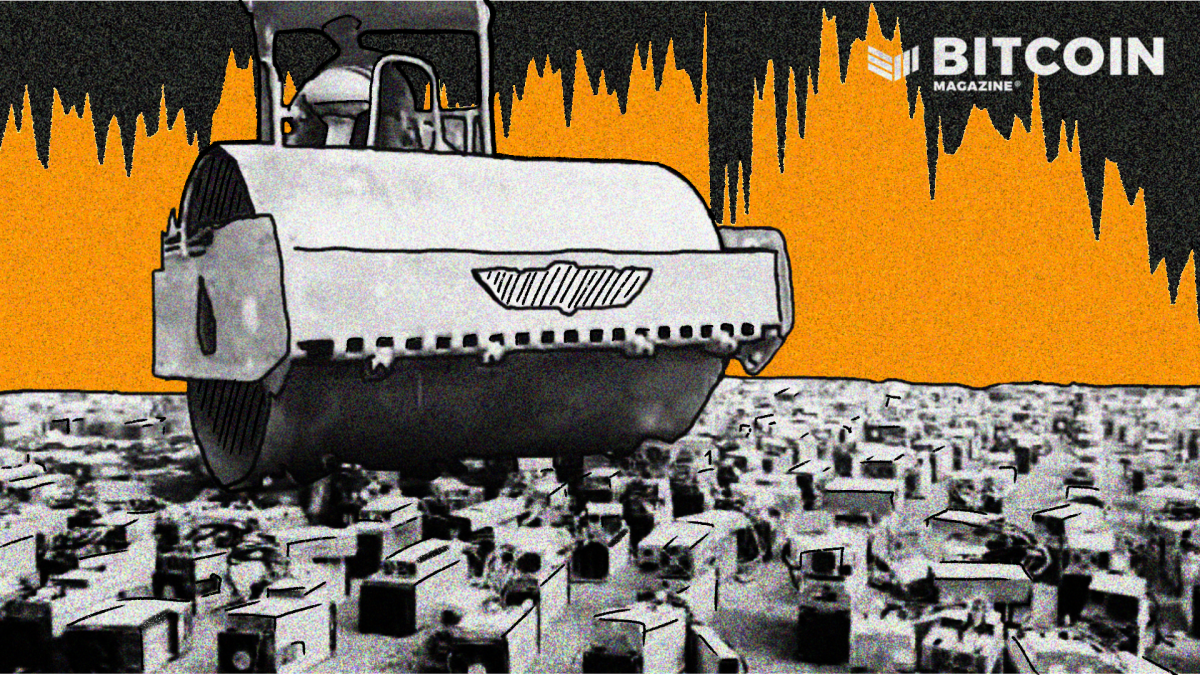This article focuses on establishing a timeline of recent mining-related events, the economics of mining at home for the average U.S. resident, some speculation on the economical future limits and some steps you can take to start mining non-KYC bitcoin at home.
If you're familiar with my other work, you know that I do not write about bitcoin price action, however, price action is relevant in this case because electricity bills are paid in fiat. Decoupling the economics of bitcoin mining from fiat conversion abstracts the subject too much to be useful for a wide audience, in my opinion. I try to keep it limited to only the relevant events and chart comparisons to demonstrate my point.
A Recent Bitcoin Mining Event Timeline
This has been an interesting year for Bitcoin with many notable events such as Whirlpool unspent capacity reaching an all-time-high, Taproot activation, El Salvador adoption, Craig Wright suing Bitcoin.org and the deaths of Mircea Popescu and John McAfee. Additionally, the network hash rate and trading price both hit all-time-highs followed by more than 50% pull backs. As turbulent as conditions were at times, this year has also been full of opportunity for those who were prepared.
On the surface, 2021 may not appear as a good time to start mining Bitcoin, but I'm going to explain why I think this is a good time to start a small, modest Bitcoin mining operation at home with the intent of dollar-cost averaging (DCAing) non-KYC bitcoin through your electricity bill. Aside from the events mentioned above, just zooming in on the mining sector is a rabbit hole all its own.
Here is a timeline of some major mining-related events that I think contributed significantly to the bullish case for mining bitcoin at home:

April 14: The BTC price peaked at a new all-time-high just under $65,000 per bitcoin. This was a short-lived peak and price momentum took a turn for the bearish by May 19 with the trading price experiencing a roughly 50% drop. This was significant to mining in that many miners could pay for their operations with only a small fraction of the bitcoin they were mining. With electricity rates near $0.03 per kilowatt hour (kWh), some operations could produce 1 bitcoin at a cost of $3,700, leaving nearly $61,000 in headroom.
April 15: The mean Bitcoin network hash rate peaked at 197 exahashes per second (Eh/s), then dropped to 106 Eh/s two days later. Clearly something happened to about 46% of the network hash rate that all shared some common denominator. Right around this time, there were reports of an incident related to a coal mine accident in Xinjiang, China which supposedly had a 30% drawdown effect on the overall Bitcoin network hash rate. Only a few weeks from this point, China would again be at the center of attention as it relates to Bitcoin mining.
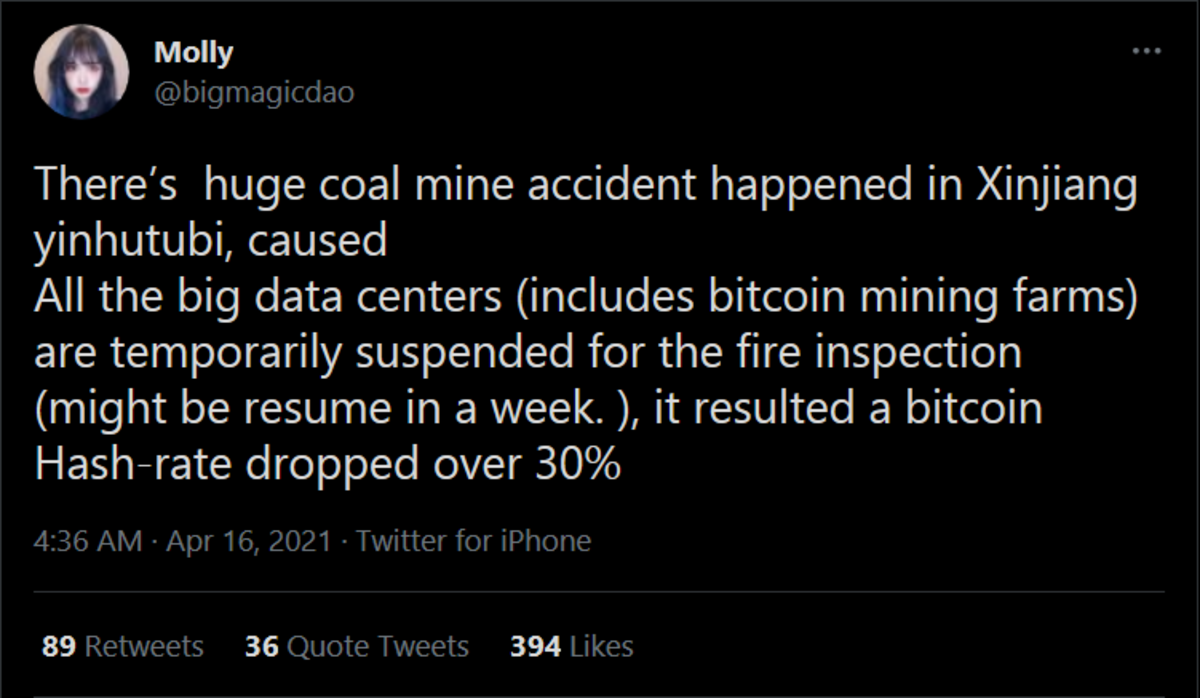
May 6: The U.S. mining company Marathon mined the first OFAC-compliant block on the Bitcoin network. This was the first instance of a major censorship initiative that I am aware of and I considered it an attack on Bitcoin. Marathon has since reversed its position on censoring transactions, however, only time will tell if their intentions are true to the censorship-resistant attributes of Bitcoin. I think this was a significant event in that I anticipated this level of attack coming from a country like China, but 2021 has been full of surprises.
May 11: For those who follow Bitcoin developments a little more closely, there is speculation that a meeting between Federal Reserve Chairman Jerome Powell and Coinbase CEO Brian Armstrong may have fueled market manipulation that had a negative effect on the upward price momentum. The timing of this meeting was coincidentally right before a massive price drawdown. This is significant in mining terms because of the effect on operating margins and potentially shadowy regulatory initiatives being discussed behind closed doors at one of the worlds largest Bitcoin exchanges.
May 12: The price broke $50,000 support levels and started falling with more velocity; likely attributable in part to fear, uncertainty and doubt (FUD) being circulated by Elon Musk related to Tesla dropping support for Bitcoin payments. The CEO cited concerns over the Bitcoin network's energy consumption. Musk touted support for Dogecoin, fueling the misconception that somehow a Bitcoin transaction requires a static amount of energy and that the network is inefficient.
May 21: With the price in clear decline, markets were shaken even further with news of a Chinese Bitcoin mining ban. The Chinese government declared that all Bitcoin mining operations must cease, desist and clear out within two months following the announcement. This was not the first announcement of its kind from the Chinese government, but there was evidence in the network hash rate disruptions that seemed to support the hypothesis that this time was different.
According to the Cambridge Bitcoin Electricity Consumption Index (CBECI), China had dominated the Bitcoin mining industry, accumulating 65% to 75% of the network hash rate. In my opinion, these percentages are inflated because I believe there is some conflation between Bitcoin mining hardware physically located within the borders of China and global Bitcoin mining operations simply owned by Chinese companies. In either case, by March 2021 the CBECI indicated that roughly 46% of the total Bitcoin network hash rate was within the borders of China. The Cambridge Centre for Alternative Finance (CCAF) took a closer look, spanning from September 2019 to April 2021, at the mining exodus from China, concluding that the percentage had dropped from 75% to 46% during that time.
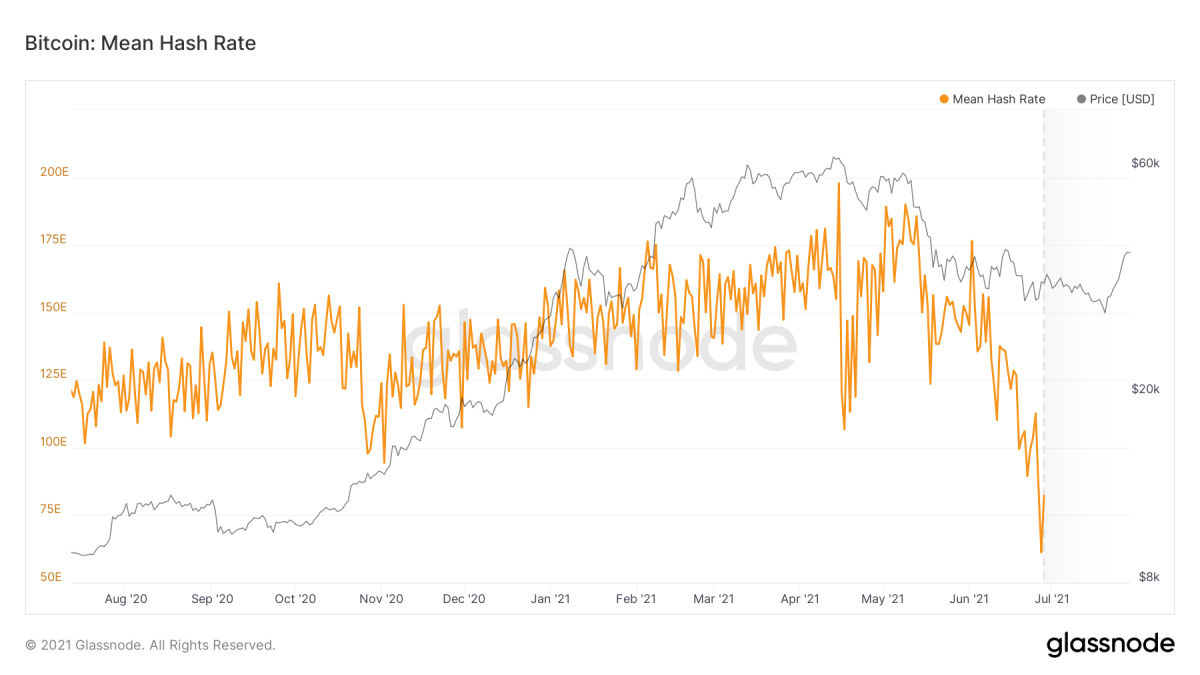
Despite the 46% drop in hash rate from the 197 Eh all-time high on April 15, it is interesting to note that the network mean hash rate climbed from 106 Eh back up to 189 Eh on May 2, only 15 days later. Then it gradually declined again to the most recent low of 61 Eh on June 27. I can only speculate that perhaps there was a big initial scare that caused most Chinese miners to shut off around April 15, likely the coal mine accident, with many mining operators scrambling to resume operations in the days that followed; only to permanently shut operations down after the Chinese government's announcement of the mining ban. Supposing that ASICs were being relocated outside of China's borders and powered back on following the China ban, overall Bitcoin network hash rate started to make a recovery. In any event, I'm not sure we'll ever know exactly what happened, but I do think there is a lot more to this story than I'm understanding at this point.
May 24: Michael Saylor threw his support behind Marathon, while it was still actively attacking the Bitcoin network by censoring transactions. Together, Saylor and Marathon teamed up and announced the Bitcoin Mining Council (BMC). Clearly, to me anyway, this was a knee-jerk reaction to the possibility of losing Musk's support for Bitcoin. The Bitcoin Mining Council was nothing more than a Hail Mary attempt from an armchair quarterback to try and secure his bags. What has transpired since has been some gold-medal-worthy mental gymnastics.
This council was convened in fear around the idea that the public at large may have a negative perception of Bitcoin due to unsubstantiated environmental concerns. Which can be extrapolated as: If institutions think Bitcoin is not environmentally friendly, then they won't invest in it; and if institutions don't invest in Bitcoin, then the price is not going to go up; and if the price doesn't go up, then Bitcoin is pointless. This number-go-up (NGU) mentality undercuts the permissionless, censorship-resistant, neutral, borderless and open attributes of Bitcoin, replacing them with this notion that Bitcoin is merely a conduit to attract more fiat. In any event, the BMC is opening the door to ESG initiatives, carbon credits and regulatory dangers that make me believe this is an attack on Bitcoin.
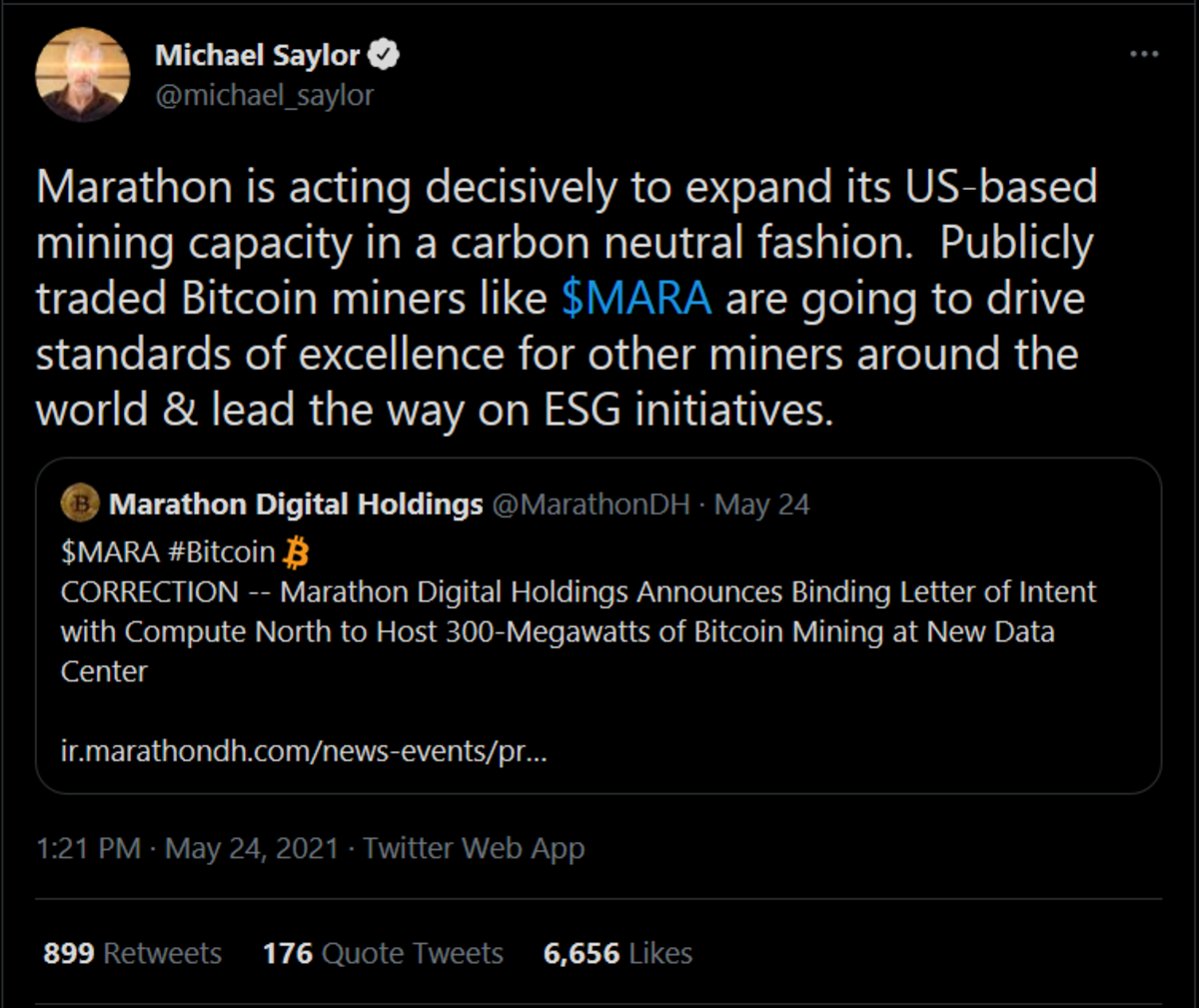
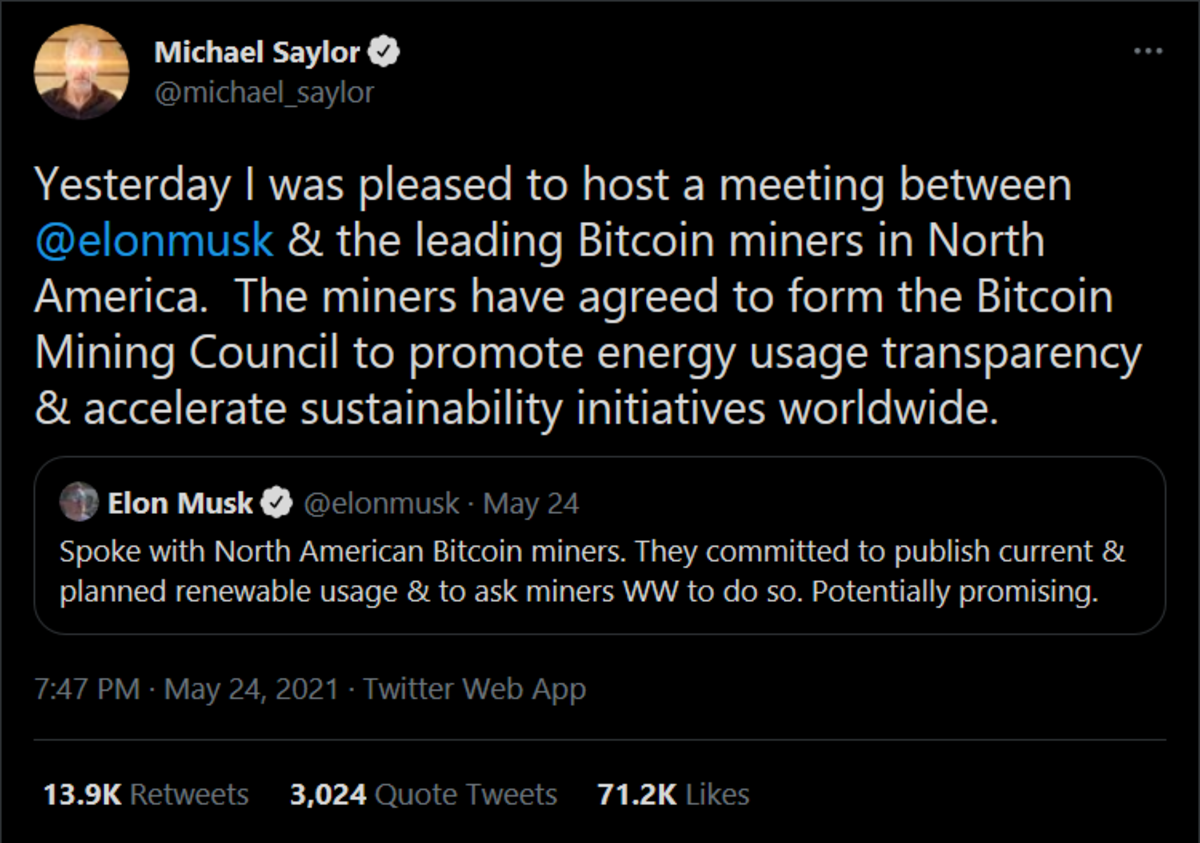
June 3: The mempool cleared for the first time since December 14, 2020. This is significant for a few reasons as it relates to mining. Transaction fee revenue can be a substantial portion of mining revenue. In fact, as the block subsidies continue to halve every 210,000 blocks, eventually the transaction fees may be the only thing incentivizing miners. There are many years before that will become a reality, but there are less than three years left before the block subsidy becomes 3.125 bitcoin per block.
The drop in transaction fees at this particular time in Bitcoin events indicates to me that Chinese miners had been running some kind of scheme that artificially boosted the transaction fees. With the absence of mining operations in China, there was no more incentive to continue these schemes. The extra fees would have boosted mining profits. A concern for larger miners that are in competition with each other, but much less of a concern for small miners trying to DCA through their electricity bill by mining at home.
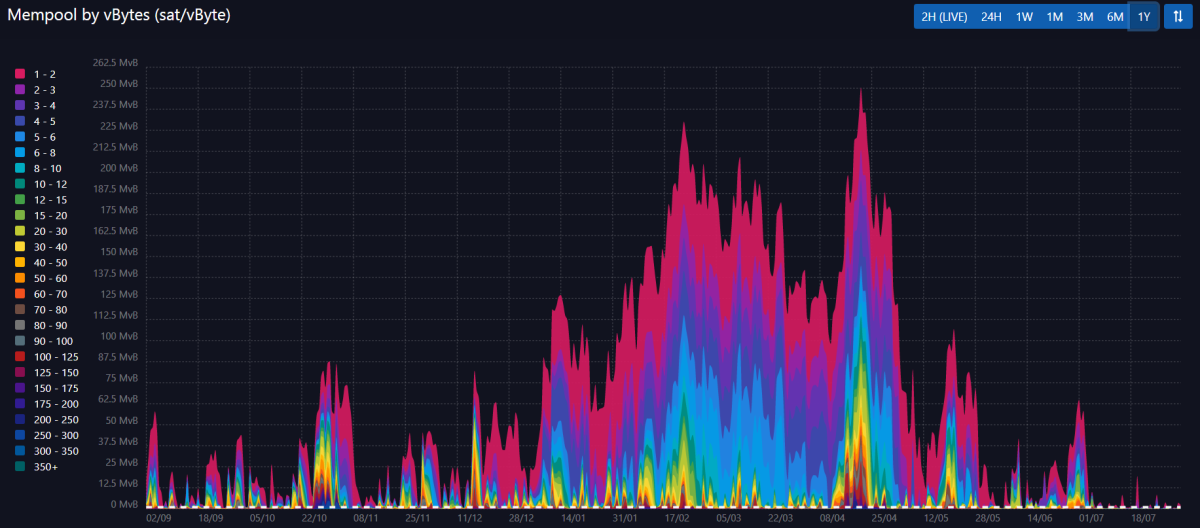
When the fee rates started climbing in January, the narrative at the time was that the rainy season in China was affecting the network hash rate so much that fees were spiking. This had a number of ripple effects, like Bisq floating the idea to build their platform on top of Liquid instead of Layer 1 Bitcoin. The problem I have with this narrative in hindsight is that the hash rate was 50% higher in January 2021 than it is now, yet fees were 300-times higher.
Why Opportunity Knocks Now For Home Bitcoin Mining
The outlook for Bitcoin was grim by the end of June. One would have to be crazy to think that investing in bitcoin, let alone mining equipment, was a good decision. Ironically, this is where the bullish case for mining non-KYC bitcoin at home starts...
There is a mechanism built into the Bitcoin protocol called the difficulty adjustment. This is how the network attempts to maintain a consistent 10-minute interval between blocks. Every 2,016 blocks, the difficulty in finding a block is adjusted depending on how much hash power has been online. The more hash power that comes online, the faster blocks are mined. If blocks are being mined too fast, then the difficult adjustment increases to try and get the interval back to 10 minutes. Alternatively, when blocks are being mined too slow, the difficulty adjustment decreases to try and get the interval back to 10 minutes.
On July 3, 2021, the Bitcoin network experienced the largest decrease in mining difficulty to date, following the drop in overall network hash power. Leading up to this adjustment, blocks were being mined slower than the 10-minute target on average. This adjustment in difficulty attempted to get that interval back on track.
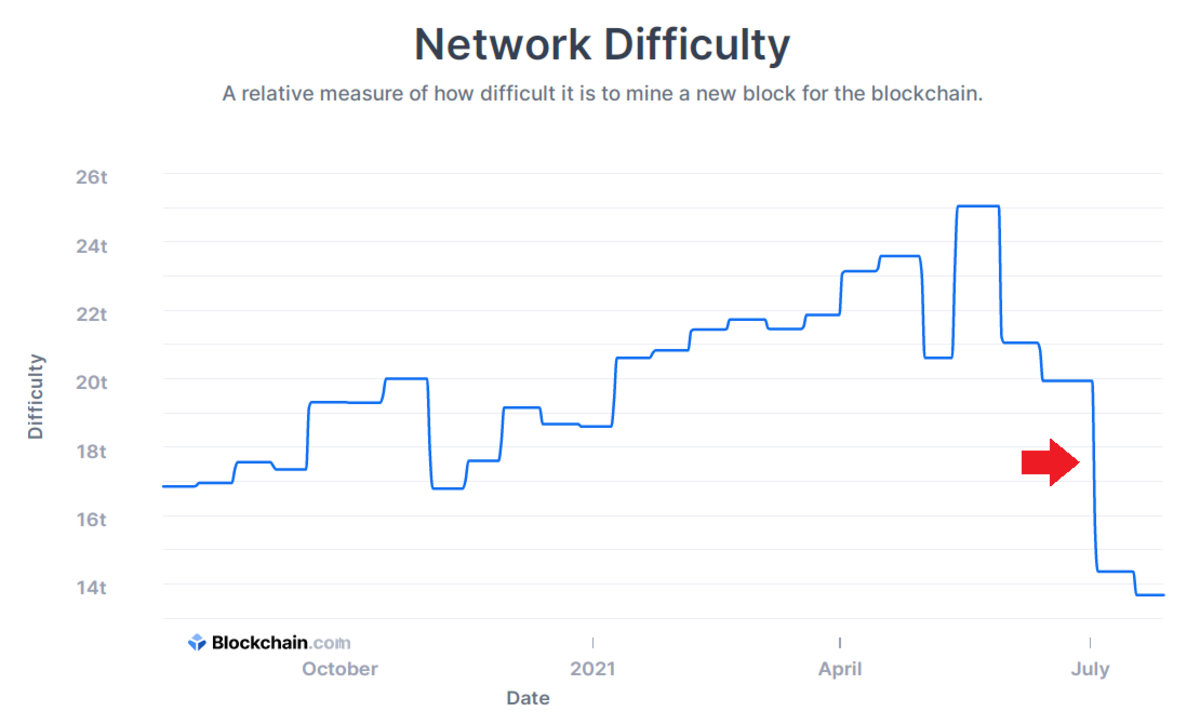
When blocks are less difficult to mine, it means that operational miners have an easier time mining blocks. Or, in other words, more blocks can be mined for the amount of provided hash power because the hash rate is staying static while the rate of block finds increases, in this case. Although nearly 50% of the hash rate had gone offline, the miners that remained online during the difficulty adjustment appreciated a nearly 30% increase in mining rewards. The difficulty adjustment made it so that the amount of bitcoin earned in mining rewards for a given amount of hash power increased by nearly 30%.
This profitability increase is not only appreciated by large mining operations, it is not an economies-of-scale advantage. It is linearly distributed to all miners based on the amount of hash power they are providing. For example, by joining a mining pool, even home miners can earn relatively consistent mining rewards. I run a single 80 terahash (Th) ASIC at home; prior to the difficulty adjustment, my ASIC was yielding approximately 0.00055 BTC daily. After the difficulty adjustment, my daily mining rewards increased in an inversely proportional way to the difficulty decrease to approximately 0.00070 BTC.
In this June 24, 2021 Twitter thread, Slush Pool explained the difficulty adjustment phenomenon and although it may seem counterintuitive at first, the decrease in difficulty provided a rare opportunity for operational miners of all sizes. These unique network and market conditions also provided a chance for those on the sidelines to jump into the mining game.
Typically, the price of ASIC hardware is closely tethered to the BTC price. As the price of bitcoin fell, mining hardware prices also fell, in relative fiat terms. Additionally, mining hardware was becoming more available as, supposedly, the ASICs leaving China needed new homes. This flood of hardware also helped relieve strains on the secondary ASIC markets that had been affected by global microchip shortages. For those who recognized the window of opportunity, this will likely go down in history as one of the best times to start a home mining operation.
Where There Is Home Mining Risk, There Is Reward
As more people became conscious of what was happening in the Bitcoin space, I started getting more DMs and emails asking if it was better to just buy bitcoin or to start mining at home. The common misconceptions had long been discouraging for small-scale home miners. Some common narratives that you have likely heard in recent years are:
- Mining is only for large operations
- Residential electricity is too expensive to mine
- You would be better off spending your money at an exchange buying BTC instead of wasting it on electricity
- Setting up a mining operation is complicated and difficult
- You will never make your money back
Many of the false narratives were shattered in Diverter's groundbreaking guide on home mining, or as he likes to call it, “garage band mining.” To see for yourself where the narratives went to die, read “Mining For The Streets.” This guide was published just after the May 2020 Halving and it wasn't until October 2020 when I read the article that I realized what was happening and the opportunity that I was missing out on, the opportunity that many people were missing out on because they assumed the narratives were true. I set out to see for myself, you know, don't trust, verify? I detailed every step of the process in my January 2021 “Home Mining For Non-KYC Bitcoin” guide. I wanted a way to increase my bitcoin holdings without using KYC, I knew DCA was the best method but the auto-DCA services require KYC. Diverter's guide showed me the solution I was looking for.
But, coming back to the questions at hand: "Am I better off dollar-cost averaging or mining?" I needed something more to show people what kind of chance they were taking by jumping into mining at home. A strong strategy for home mining is to start small and build your knowledge, skills and commitment slowly. There are so many variables, like electricity rate, hardware cost, unique home environment, network hash rate and BTC price. There is no way I can tell anybody this is a viable solution for them, nor can I say it isn't. The best thing I can do is provide the information one needs to let them make an informed decision for themselves and explain that their decision depends on what they think the near future holds for the BTC price and the Bitcoin hash rate and how creative they can get in solving heat or noise problems.
On July 13, 2021, I posted this Twitter thread presenting a few charts I had put together by compiling 12 months worth of BTC price, network hash rate and daily mining rewards data. Some have said that I'm cherry picking the data, which is bullshit. I presented 12-months worth of data, I did not remove any unfavorable data from the set. I even posted my spreadsheet and accompanying files on GitHub in a repository available for anyone to fork and modify however they want. I already put the first 12 months of historical data together and I would encourage anyone to put the work in to expand that data set if they want to.
Probably the biggest factor in making the decision to mine at home is going to be your electricity rate. In my data set, I put four different rates together representing a range of users. The average rate for electricity in the United States is $0.13 per kWh, so that is what I'll be focusing on the most. I used the specifications of my own hardware for some baseline ASIC variables: 80 Th/s at 3,500 watts consumption. This is a modest setup that one could obtain for roughly $5,000 or 0.125 BTC in these market conditions.
I'm going to share with you four charts that I made using the above information. I thought that these four charts illustrated the information needed to provide insight into the most pressing questions. Only the second chart accounts for the initial hardware cost (0.125 BTC or $5,000) my reasoning is that:
- I want to focus on the impact dollar-cost averaging has between an exchange and an electricity bill.
- In my opinion, the upfront cost is a wash since you will likely either buy a lump sum of bitcoin with the money or use that money to buy an ASIC, in either case what happens by dollar-cost averaging after the fact is what I wanted to focus on. If you bought a lump sum of bitcoin, it will probably just sit in cold storage anyways so I don't see why you wouldn't deploy that capital in mining equipment and put your money to work. However, for due diligence my fourth chart takes the upfront cost into account.
The first chart displays the cumulative amount of bitcoin you would have stashed away if you had dollar-cost averaged the amount paid in electricity versus mining directly. You can see that right around 10 months into mining, you would have surpassed the amount of bitcoin accumulated in total at $0.13 per kWh.
Had you been spending $21 per day dollar-cost averaging (the equivalent of paying $0.25 per kWh), then you would have gotten off to a significant head start at the beginning of the year. But for the average U.S. home miner, playing the long game would have paid off.
Bitcoin is supposed to help a person develop a low time preference, and I think that successful miners understand this concept well. This chart shows you roughly how long it would take to get your return on investment (ROI) if you deploy some amount of bitcoin to procure an ASIC. For example, if you had spent 0.125 BTC to buy your ASIC, then after about seven months you would have earned your bitcoin back. After that point, you are running an ASIC that's paid for and accumulating more bitcoin than you would have had in the first place if you had just bought a lump sum and then stopped accumulating.
The important takeaway for me from this chart is the idea that, more likely than not, you're just going to be holding your bitcoin in cold storage for the foreseeable future anyway. Why not put some of that capital to work in a way that will return the investment in roughly one year, plus provide you with the hardware needed to then increase your holdings? Many S9 Antminers are still running profitably to this day, five years after being deployed. It is a reasonable assumption that today's new generation of ASICs will also be running profitably well into the next subsidy epoch.

The second chart takes the first chart into account and also displays the upfront hardware cost. Special thanks to @6102bitcoin for encouraging me to make this particular chart, I think this is the more objective approach. The assumption here is that if you had a lump sum of money, roughly $5,000, you will either buy 0.125 BTC with it or you will buy an ASIC. This chart shows the outcomes over the last year if you had started with 0.125 BTC and then in addition dollar-cost averaged the same amount you would have been paying in electricity to run the ASIC. You can see the trend line for mining starts at zero since you would have spent your money on the ASIC instead of bitcoin, whereas the other trend lines start at 0.125 BTC.
At first glance, over the last 12 months, if your electricity rate was greater than $0.06 per kWh, then you would have been better off buying 0.125 worth of bitcoin and then dollar-cost averaging the same amount that you would have been spending on electricity.
However, I think it is noteworthy that the mining trend line is closer to being linear as mining accumulates a more consistent amount of bitcoin. Compared to the DCA trend lines, they are more vertical while the price of bitcoin is lower since you get more for your money, but they begin to flatten out as the price of bitcoin increases because you get less for your money. Again, this all comes down to what you believe lies ahead for the price of bitcoin and the network hash rate. Eventually, I believe the trend line for mining will intersect and surpass all the DCA trend lines. But if you pay more than $0.06 per kWh, that could take more than a year based on the last 12 months of data.

Another important consideration to think about while looking at this chart is that the ASIC hardware price is closely tethered to the price of BTC. For example, a Whatsminer M31S+ purchased in December 2020 quadrupled in value by April 2021. If the price of BTC goes up, then your asset appreciates in value and if the price of BTC goes down, then your daily mining rewards are likely to go up as other mining operators go offline and hash rate decreases.
The third chart shows the amount of bitcoin you would have accumulated daily had you been spending your money dollar-cost averaging versus paying the electricity to run an ASIC. For example, what would get you the most bitcoin, DCA with $10.92 per day or pay $10.92 per day in electricity? You can see that for roughly the first quarter of the year, you would have been stacking more BTC by just buying at an exchange.
But that changed around mid-November 2020 when mining at $0.13 per kWh would have been breaking even with the DCA method. What happened mid-November 2020? The price of BTC broke $16,000 and the network hash rate was around 125 Eh/s. By mid-December, when BTC broke $20,000 and the network hash rate was still around 125 Eh/s to 130Eh/s, mining at $0.13 per kWh started to become more profitable than breakeven. Which means that by dollar-cost averaging with an exchange, you would have been getting less bitcoin for your money.
However, by using that same amount of money to pay for the electricity, you would be getting more bitcoin.
One way of looking at this is: At $0.13 per kWh, you will break even mining as long as BTC stays above $15,000 and the network hash rate stays below 135 Eh. Call me bullish, but I don't think BTC is going back to $15,000, but I do think the hash rate will surpass 135 Eh/s. So, even if the hash rate spiked from there to 250 Eh/s, then so long as the BTC price held $28,000, you would still be breaking even by mining.
Do you really think that if Bitcoin shattered it's all-time-high hashrate of 197 Eh/s by another 21% that the price of BTC would be below $28,000? I think that's a safe margin of error and I'm placing my bets that the price does not drop below $15,000 or that the hash rate spikes above 250 Eh during the remainder of this 6.25 BTC subsidy epoch.

The fourth chart displays the USD value profitability of mining based on kWh rate. You can see that from February through May, when BTC was trading above $35,000, even paying $0.25 per kWh was profitable. At the peak you would have been paying $21.00 per day in electricity but earning about $33 in bitcoin. There were points in the last year when you would have been earning $3 in BTC for every $1 you spent on electricity at $0.13 per kWh. Think about that: At the U.S. average electrical rate you would have been accumulating bitcoin at 66% below market price.

To recap my main points form this section based on a modest single 80 terahash (Th) ASIC and paying the U.S. average $0.13 per kWh:
- Network hash rate could climb to 250 Eh and you would still be profitable mining so long as BTC held $28,000. Or if BTC fell to $15,000, then so long as the network hash rate stayed below 135 Eh, then you would still be breaking even.
- I am placing my bets on the network hash rate not breaking 250 Eh and the price not dropping below $15,000.
- Why not put some of your capital to work if you're just going to keep it in cold storage anyway? Get an ASIC, get your ROI after about a year and then keep that nominal number growing.
- Nobody can deny that DCA is the best accumulation method. But by doing it through your electric bill, you can get bitcoin for a substantial percentage below market price while avoiding KYC.
- If you take upfront hardware costs into account, you may be better off just buying bitcoin if you pay more than $0.06 per kWh in the near term. However, I think mining is a long game and if you're serious about it, then it is better than auto-DCA for a number of reasons beyond just the accumulation of discounted bitcoin, such as the lack of KYC risk, enhanced privacy and the fact that mining is permissionless.
Another important consideration: There is no KYC involved with mining at home. Here is an example of the accumulative USD value of custodial BTC in a 6102-style event:
Auto-DCA services use KYC and keep custody of your bitcoin until you withdraw to your own wallet. You could be censored from accessing your bitcoin overnight in that situation. Even if you withdraw your bitcoin to your own custody, it is still attached to your identity because of the KYC. In a hostile, 6102-style event, you would have a target on your back if taking self custody.
There are services that provide automatic withdrawals to your own Bitcoin wallet, which is a good start for self-custody. The issue is that these services require KYC which irrevocably attaches your identity to a bitcoin purchase. Simply having custody of your bitcoin will not safe guard you from a hostile 6102-style event. Mining at home is impervious to this effect as there is no KYC involved.
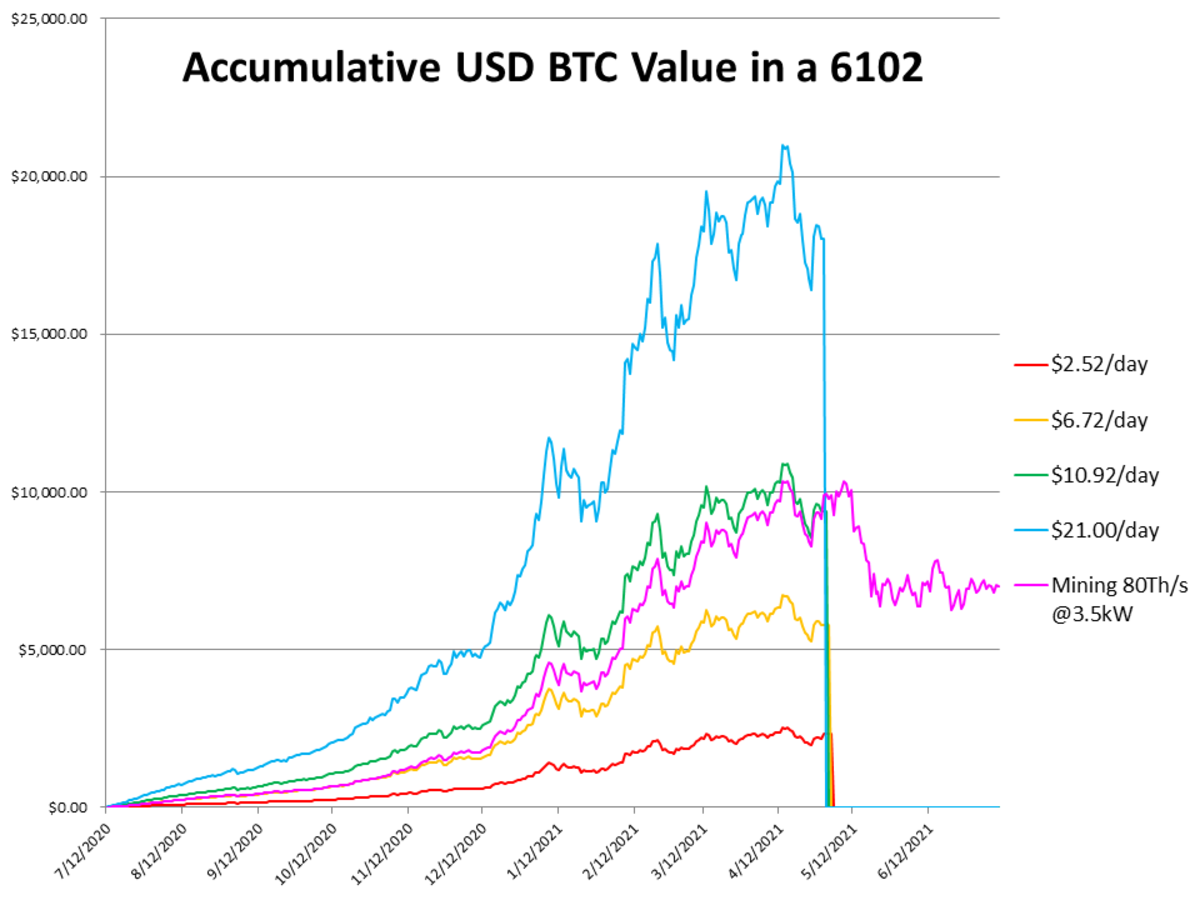
How To Get Started Mining Bitcoin From Home
If you are interested in learning more about mining non-KYC bitcoin at home, you can find all the information you need by reading Diverter's guide: “Mining For The Streets” or my guide “Home Mining For Non-KYC Bitcoin.”
Sourcing: Start by looking for ads in the Telegram channel “Hardware Market Verified Listings.” The sellers who post here have given their identification to the channel admin. This is not a silver bullet against scammers, but it is a good start. If you have any hesitations, reach out to someone like myself or Diverter or RoninMiner for advice.

When you find an ad for something you want, don't hesitate because there is a minimum order quantity (MOQ). Contact the seller and get on their radar. Many sellers will consolidate small orders to reach their MOQ. Once you strike a deal, be patient, it will likely take a month or longer from the time you submit your payment until your hardware arrives.
Ventilation: ASIC's produce a lot of heat and you will need to do something with it, otherwise you will heat up the space that the ASIC is in and it won't run if it overheats. You need to think about how you will provide adequate ventilation.
Some people try to capture this heat to use in warming their homes and there is no shortage of creative solutions that can apply here. For myself, I decided to pull cool air in from outdoors and just vent the hot air back out through a nearby window. I also installed an inline duct fan to help keep the air moving.
Noise: ASIC's are loud — very, very loud. The ASIC I've been using for an example in this article will be around 95 decibels (dB). For reference, that's roughly as loud as having a lawn mower running in your living room.
So, you need to make careful considerations about how you will handle these noise levels... these 24/7 constant noise levels. If you have a family, their sanity is at stake, so plan carefully. If you can get even a 10 dB attenuation, it will make all the difference in the world. This is easier to do than you may think, it can be done by building a simple enclosure that still allows for adequate ventilation or by installing your ASIC in a basement or garage. For my setup, I built an enclosure out of plywood and medium-density fibreboard (MDF). Consider using fire-rated materials instead if you decide to go this route.
Electrical: Make sure that you have the appropriate electrical infrastructure ready to go for your new hardware. These ASICs need 240 volt power sources and one ASIC will pull roughly 15 amps. For example, if you want to run two 80 Th ASIC's at 3,500 watts each, make sure you have at least a 30 amp dedicated circuit run in 8 American wire gauge (AWG) terminated to two outlets, typically with NEMA 6-20 receptacles.
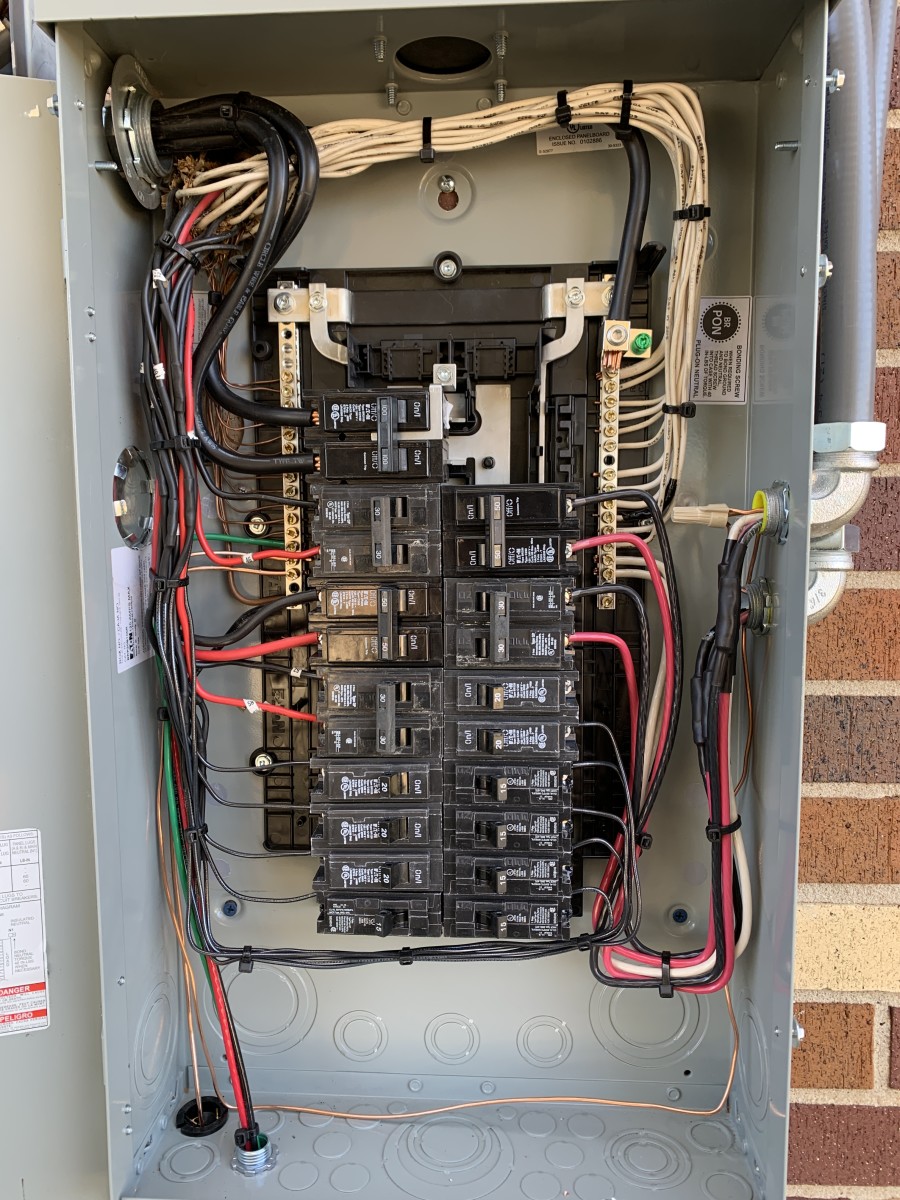
Now, if you have no idea what I just said, that is a great indicator that it's time to call a licensed electrician. They are not as expensive as you may think and no amount of bitcoin is worth the safety of you and your family.
Pool: By connecting to a mining pool, you will be combining your hash power with that of many other miners and together, the entirety of the pool's hash power is used to work in a coordinated effort in solving for a block.
You technically can run a solo miner with your own node or with CK Pool. The disadvantage is that if you do not find a block, then you do not get any rewards. But if you did find a block then you would get 98% of the block subsidy (6.25 BTC) plus the transaction fees mining with CK Pool. For example, on June 3, 2020, a single 50 Th S17 mined a block solo. Personally, I joined Slush Pool and consistently stack mining rewards daily as the pool finds blocks.
Connecting to a pool is the easiest part about all of this. You plug your ASIC into power, connect it to the internet with an Ethernet cable, then open a web browser on your local network and log into your ASIC with the IP address, kind of like how you log into your home router. Once logged in, simply copy/paste the pool URL in your miner's configuration page and that's it, you're done.
Then you can log into your pool's dashboard to monitor your miner's status and input the Bitcoin address you want your funds deposited to. I recommend updating your Bitcoin deposit address often and not reusing it. Slush Pool, for example, doesn't require any identifying information other than an email address to set up an account. Be aware of this looming threat posed by creeping KYC regulations, Slush Pool gives its detailed perspective on current events in this Twitter thread.
Conclusion
I'm bullish on mining non-KYC bitcoin at home. It's not like you're trying to compete with institutional mining operations. You're just trying to DCA through your electric bill.
I think that the majority of people can mine bitcoin at home profitably. There is a wide range of margin where mining will continue to be profitable, even for home miners on residential electrical rates. Mining at home is safer and more private than using a KYC service to accumulate bitcoin.
I hope that this article has given you some insight into notable Bitcoin events this year as they relate to mining and how this has affected the landscape. I can't tell you if mining is right for you or not, that is a decision you will have to arrive at on your own. I have tried to put together as much information as I can and offer my perspective on it so that you can make a more informed decision for yourself.
To learn more, check out Episode 0.3.1 of Citadel Dispatch by Matt Odell, featuring Diverter, RoninMiner and myself.
This is a guest post by Econoalchemist. Opinions expressed are entirely their own and do not necessarily reflect those of BTC Inc or Bitcoin Magazine.


